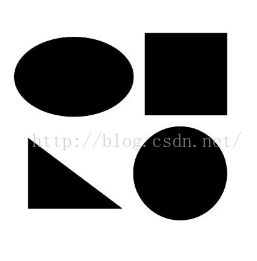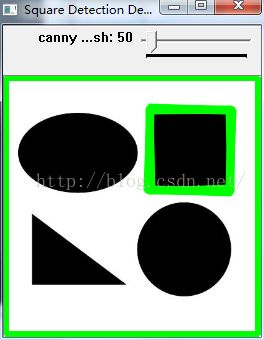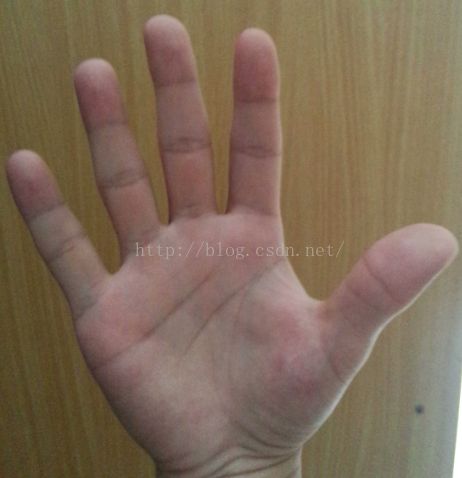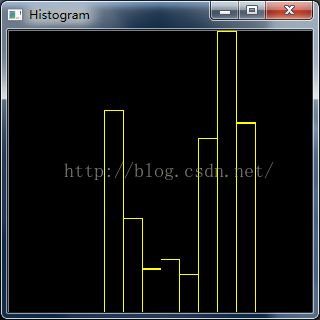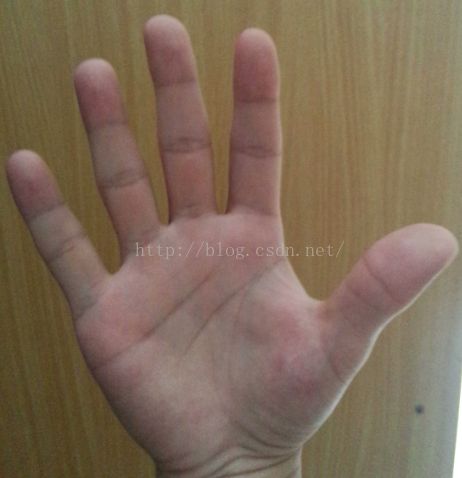图像特征提取的总结(续)
续上一章
6,hough矩形提取
#include "cv.h"
#include "highgui.h"
#include <stdio.h>
#include <math.h>
#include <string.h>
int thresh = 50;
IplImage* img = 0;
IplImage* img0 = 0;
CvMemStorage* storage = 0;
CvPoint pt[4];const char* wndname = "Square Detection Demo";
double angle( CvPoint* pt1, CvPoint* pt2, CvPoint* pt0 )
{
double dx1 = pt1->x - pt0->x;
double dy1 = pt1->y - pt0->y;
double dx2 = pt2->x - pt0->x;
double dy2 = pt2->y - pt0->y;
return (dx1*dx2 + dy1*dy2)/sqrt((dx1*dx1 + dy1*dy1)*(dx2*dx2 + dy2*dy2) + 1e-10);
}
CvSeq* findSquares4( IplImage* img, CvMemStorage* storage )
{
CvSeq* contours;
int i, c, l, N = 11;
CvSize sz = cvSize( img->width & -2, img->height & -2 );
IplImage* timg = cvCloneImage( img );
IplImage* gray = cvCreateImage( sz, 8, 1 );
IplImage* pyr = cvCreateImage( cvSize(sz.width/2, sz.height/2), 8, 3 );
IplImage* tgray;
CvSeq* result;
double s, t;
CvSeq* squares = cvCreateSeq( 0, sizeof(CvSeq), sizeof(CvPoint), storage );
cvSetImageROI( timg, cvRect( 0, 0, sz.width, sz.height ));
// down-scale and upscale the image to filter out the noise
cvPyrDown( timg, pyr, 7 );
cvPyrUp( pyr, timg, 7 );
tgray = cvCreateImage( sz, 8, 1 );
// find squares in every color plane of the image
for( c = 0; c < 3; c++ )
{
cvSetImageCOI( timg, c+1 );
cvCopy( timg, tgray, 0 );
for( l = 0; l < N; l++ )
{
if( l == 0 )
{
cvCanny( tgray, gray, 0, thresh, 5 );
cvDilate( gray, gray, 0, 1 );
}
else
{
cvThreshold( tgray, gray, (l+1)*255/N, 255, CV_THRESH_BINARY );
}
cvFindContours( gray, storage, &contours, sizeof(CvContour),CV_RETR_LIST, CV_CHAIN_APPROX_SIMPLE, cvPoint(0,0) );
while( contours )
{
result = cvApproxPoly( contours, sizeof(CvContour), storage,CV_POLY_APPROX_DP, cvContourPerimeter(contours)*0.02, 0 );
if( result->total == 4 && fabs(cvContourArea(result,CV_WHOLE_SEQ)) > 1000 && cvCheckContourConvexity(result) )
{
s = 0;
for( i = 0; i < 5; i++ )
{
if( i >= 2 )
{
t = fabs(angle( (CvPoint*)cvGetSeqElem( result, i ),(CvPoint*)cvGetSeqElem( result, i-2 ),(CvPoint*)cvGetSeqElem( result, i-1 )));
s = s > t ? s : t;
}
}
if( s < 0.3 )
for( i = 0; i < 4; i++ )
cvSeqPush( squares,
(CvPoint*)cvGetSeqElem( result, i ));
}
contours = contours->h_next;
}
}
}
cvReleaseImage( &gray );
cvReleaseImage( &pyr );
cvReleaseImage( &tgray );
cvReleaseImage( &timg );
return squares;
}
// the function draws all the squares in the image
void drawSquares( IplImage* img, CvSeq* squares )
{
CvSeqReader reader;
IplImage* cpy = cvCloneImage( img );
int i;
cvStartReadSeq( squares, &reader, 0 );
for( i = 0; i < squares->total; i += 4 )
{
CvPoint* rect = pt;
int count = 4;
memcpy( pt, reader.ptr, squares->elem_size );
CV_NEXT_SEQ_ELEM( squares->elem_size, reader );
memcpy( pt + 1, reader.ptr, squares->elem_size );
CV_NEXT_SEQ_ELEM( squares->elem_size, reader );
memcpy( pt + 2, reader.ptr, squares->elem_size );
CV_NEXT_SEQ_ELEM( squares->elem_size, reader );
memcpy( pt + 3, reader.ptr, squares->elem_size );
CV_NEXT_SEQ_ELEM( squares->elem_size, reader );
cvPolyLine( cpy, &rect, &count, 1, 1, CV_RGB(0,255,0), 3, CV_AA, 0 );
}
cvShowImage( wndname, cpy );
cvReleaseImage( &cpy );
}
void on_trackbar( int a )
{
if( img )
drawSquares( img, findSquares4( img, storage ) );
}
char* names[] = { "a5.png", 0 };
int main(int argc, char** argv)
{
int i, c;
storage = cvCreateMemStorage(0);
for( i = 0; names[i] != 0; i++ )
{
img0 = cvLoadImage( names[i], 1 );
if( !img0 )
{
printf("Couldn't load %s\n", names[i] );
continue;
}
img = cvCloneImage( img0 );
cvNamedWindow( wndname, 1 );
cvCreateTrackbar( "canny thresh", wndname, &thresh, 1000, on_trackbar );
on_trackbar(0);
c = cvWaitKey(0);
cvReleaseImage( &img );
cvReleaseImage( &img0 );
cvClearMemStorage( storage );
if( c == 27 )
break;
}
cvDestroyWindow( wndname );
return 0;
}
7,边缘直方图提取
#include "cv.h"
#include "highgui.h"
#include <stdio.h>
#include <ctype.h>
#define PI 3.14
int main()
{
IplImage *src = 0; // source imagre
IplImage *histimg = 0; // histogram image
CvHistogram *hist = 0; // define multi_demention histogram
IplImage* canny;
CvMat* canny_m;
IplImage* dx; // the sobel x difference
IplImage* dy; // the sobel y difference
CvMat* gradient; // value of gradient
CvMat* gradient_dir; // direction of gradient
CvMat* dx_m; // format transform to matrix
CvMat* dy_m;
CvMat* mask;
CvSize size;
IplImage* gradient_im;
int i,j;
float theta;
int hdims = 8; // 划分HIST的个数,越高越精确
float hranges_arr[] = {-PI/2,PI/2}; // 直方图的上界和下界
float* hranges = hranges_arr;
float max_val; //
int bin_w;
src=cvLoadImage("h3.png", 0); // force to gray image
if(src==0) return -1;
cvNamedWindow( "Histogram", 0 );
//cvNamedWindow( "src", 0);
size=cvGetSize(src);
canny=cvCreateImage(cvGetSize(src),8,1);//边缘图像
dx=cvCreateImage(cvGetSize(src),32,1);//x方向上的差分//此处的数据类型为U 不怕溢出吗?
dy=cvCreateImage(cvGetSize(src),32,1);
gradient_im=cvCreateImage(cvGetSize(src),32,1);//梯度图像
canny_m=cvCreateMat(size.height,size.width,CV_32FC1);//边缘矩阵
dx_m=cvCreateMat(size.height,size.width,CV_32FC1);
dy_m=cvCreateMat(size.height,size.width,CV_32FC1);
gradient=cvCreateMat(size.height,size.width,CV_32FC1);//梯度矩阵
gradient_dir=cvCreateMat(size.height,size.width,CV_32FC1);//梯度方向矩阵
mask=cvCreateMat(size.height,size.width,CV_32FC1);//掩码
cvCanny(src,canny,60,180,3);//边缘检测
cvConvert(canny,canny_m);//把图像转换为矩阵
cvSobel(src,dx,1,0,3);// 一阶X方向的图像差分:dx
cvSobel(src,dy,0,1,3);// 一阶Y方向的图像差分:dy
cvConvert(dx,dx_m);
cvConvert(dy,dy_m);
cvAdd(dx_m,dy_m,gradient); // value of gradient//梯度不是等于根号下x的导数的平方加上y导数的平方吗?
cvDiv(dx_m,dy_m,gradient_dir); // direction
for(i=0;i<size.height;i++)
for(j=0;j<size.width;j++)
{
if(cvmGet(canny_m,i,j)!=0 && cvmGet(dx_m,i,j)!=0)//此行是什么意思?只看边缘上的方向?
{
theta=cvmGet(gradient_dir,i,j);
theta=atan(theta);
cvmSet(gradient_dir,i,j,theta);
}
else
{
cvmSet(gradient_dir,i,j,0);
}
}
hist = cvCreateHist( 1, &hdims, CV_HIST_ARRAY, &hranges, 1 );
// 创建一个指定尺寸的直方图,并返回创建的直方图指针
histimg = cvCreateImage( cvSize(320,200), 8, 3 ); // 创建一个图像,通道
cvZero( histimg ); // 清;
cvConvert(gradient_dir,gradient_im);//把梯度方向矩阵转化为图像
cvCalcHist( &gradient_im, hist, 0, canny ); // 计算直方图
cvGetMinMaxHistValue( hist, 0, &max_val, 0, 0 ); // 只找最大值
cvConvertScale( hist->bins, hist->bins, max_val ? 255. / max_val : 0., 0 );
// 缩放bin 到区间[0,255] ,比例系数
cvZero( histimg );
bin_w = histimg->width /16; // hdims: 条的个数,则bin_w 为条的宽度
// 画直方图
for( i = 0; i < hdims; i++ )
{
double val = ( cvGetReal1D(hist->bins,i)*histimg->height/255 );
// 返回单通道数组的指定元素, 返回直方图第i条的大小,val为histimg中的i条的高度
CvScalar color = CV_RGB(255,255,0); //(hsv2rgb(i*180.f/hdims);//直方图颜色
cvRectangle( histimg, cvPoint(100+i*bin_w,histimg->height),cvPoint(100+(i+1)*bin_w,(int)(histimg->height - val)), color, 1, 8, 0 ); // 画直方图——画矩形,左下角,右上角坐标
}
cvShowImage( "src", src);
cvShowImage( "Histogram", histimg );
cvWaitKey(0);
cvDestroyWindow("src");
cvDestroyWindow("Histogram");
cvReleaseImage( &src );
cvReleaseImage( &histimg );
cvReleaseHist ( &hist );
return 0;
}
8,视频流中边缘检测
#include "highgui.h"
#include "cv.h"
#include "stdio.h"
#include <ctype.h>
int main(int argc,char ** argv)
{
IplImage * laplace = 0;
IplImage * colorlaplace = 0;
IplImage * planes[3] = {0,0,0};
CvCapture *capture = 0;
//从摄像头读取
/*if(argc == 1 ||( argc==2 && strlen(argv[1])==1 && isdigit(argv[1][0]) ))
capture = cvCaptureFromCAM(argc == 2 ? argv[1][0] -'0':0);*/
//从文件中读取
/* else if(argc == 2)*/
capture = cvCaptureFromAVI("vedio1.avi");
if(!capture)
{
fprintf(stderr,"Could not initialize capturing...\n");
return -1;
}
cvNamedWindow("Laplacian",1);
cvNamedWindow("video",1);
//循环捕捉,直到用户按键跳出循环体
for(;;)
{
IplImage * frame =0; //抓起一祯
frame = cvQueryFrame(capture);
if(!frame)
break;
if(!laplace)
{
//创建图像
for(int i=0;i<3;i++)
planes[i] = cvCreateImage(cvSize(frame->width,frame->height),IPL_DEPTH_8U,1);
laplace = cvCreateImage(cvSize(frame->width,frame->height),IPL_DEPTH_16S,1);
colorlaplace=cvCreateImage(cvSize(frame->width,frame->height),IPL_DEPTH_8U,3);
}
cvCvtPixToPlane(frame,planes[0],planes[1],planes[2],0);
for(int i=0;i<3;i++)
{
//交换,如通道变换
cvLaplace(planes[i],laplace,3);
//使用线性变换转换输入函数元素成为无符号整形
cvConvertScaleAbs(laplace,planes[i],1,0);
}
cvCvtPlaneToPix(planes[0],planes[1],planes[2],0,colorlaplace);
//结构相同(- 顶—左结构,1 - 底—左结构)
colorlaplace->origin = frame->origin;
//高斯滤波,平滑图像
// cvSmooth(colorlaplace, colorlaplace, CV_GAUSSIAN, 1, 0, 0);
//形态学滤波,闭运算
cvDilate(colorlaplace, colorlaplace, 0, 1);//膨胀
cvErode(colorlaplace, colorlaplace, 0, 1);//腐蚀
cvShowImage("video", frame);
cvShowImage("Laplacian",colorlaplace);
if(cvWaitKey(10)>0)
break;
}
cvReleaseCapture(&capture);
cvDestroyWindow("Laplacian");
cvDestroyWindow("video");
return 0;
}
9,纹理提取
#include <iostream>
#include <math.h>
#include "cv.h"
#include "highgui.h"
int main(int argc, char* argv[])
{
int tmp[8]={0};
int sum=0;int k=0;
IplImage* img,*dst;
img=cvLoadImage("h3.png",0);
CvScalar s;
cvNamedWindow("img",NULL);
cvNamedWindow("dst",NULL);
cvShowImage("img",img);
uchar* data=(uchar*)img->imageData;
int step=img->widthStep;
dst=cvCreateImage(cvSize(img->width,img->height),img->depth,1);
dst->widthStep=img->widthStep;
for(int i=1;i<img->height-1;i++)
for(int j=1;j<img->width-1;j++)
{
if(data[(i-1)*step+j-1]>data[i*step+j]) tmp[0]=1;
else tmp[0]=0;
if(data[i*step+(j-1)]>data[i*step+j]) tmp[1]=1;
else tmp[1]=0;
if(data[(i+1)*step+(j-1)]>data[i*step+j]) tmp[2]=1;
else tmp[2]=0;
if (data[(i+1)*step+j]>data[i*step+j]) tmp[3]=1;
else tmp[3]=0;
if (data[(i+1)*step+(j+1)]>data[i*step+j]) tmp[4]=1;
else tmp[4]=0;
if(data[i*step+(j+1)]>data[i*step+j]) tmp[5]=1;
else tmp[5]=0;
if(data[(i-1)*step+(j+1)]>data[i*step+j]) tmp[6]=1;
else tmp[6]=0;
if(data[(i-1)*step+j]>data[i*step+j]) tmp[7]=1;
else tmp[7]=0;
for(k=0;k<=7;k++)
sum+=abs(tmp[k]-tmp[k+1]);
sum=sum+abs(tmp[7]-tmp[0]);
if (sum<=2)
s.val[0]=(tmp[0]*128+tmp[1]*64+tmp[2]*32+tmp[3]*16+tmp[4]*8+tmp[5]*4+tmp[6]*2+tmp[7]);
else s.val[0]=59;
cvSet2D(dst,i,j,s);
}
cvShowImage("dst",dst);
cvWaitKey(-1);
return 0;
}
(完)
